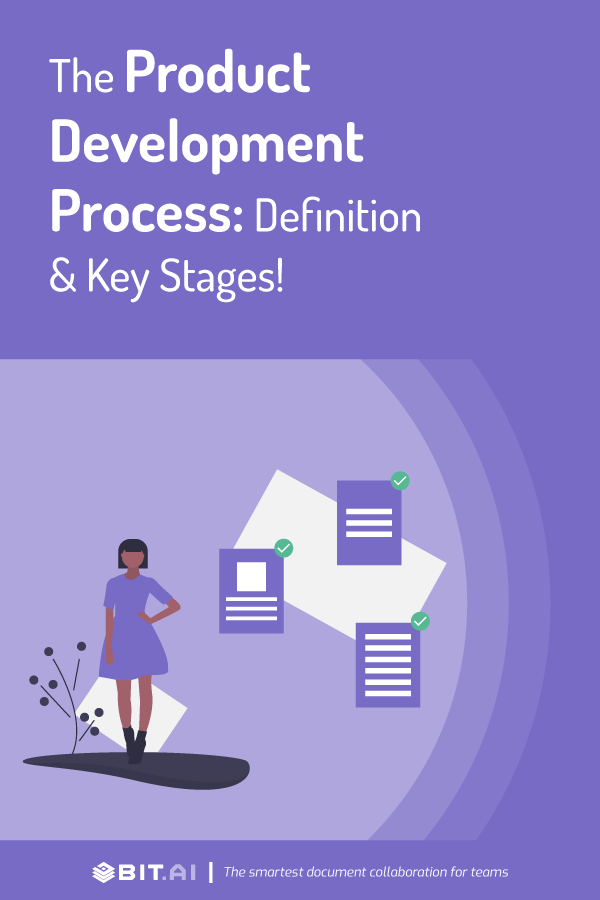Did you know that according to research by Harvard University, 30,000+ new products are developed and introduced every year in the market!
Sadly, not every business succeeds in developing the perfect product, in fact, 95% of new products launched fail! What could be the reason? Lack of demand or perhaps poor marketing efforts?
Well, one of the major reasons behind this number is an imperfect product development process. A successful product requires the perfect formula for product development.
However, developing new products can be quite intimidating and developers undermine the significance of this process!
Today, we are going to guide you through this product development process for both new products and those undergoing a revamp! Before we begin, let’s delve into what exactly is the product development process and its importance!
What is the Product Development Process? (Definition)
A product development process is the step-by-step procedure of all the actions needed to take a product from its initial concept to its market presence.
It typically consists of several phases in the complex process of delivering new products and transforming a product idea into marketable merchandise.
During the process, you start with an idea or concept and conclude with product specifications, a pricing strategy, service components, and distribution strategies. At its origin, this process must be idea-driven or market-driven!
The product development process aims to not only create something new but, above all, to maximize the product value and mitigate the risks of failures, caused by:
- poor quality,
- noncompetitive pricing,
- delayed or premature entry,
- low brand awareness and weak promotional support.
Why is a Product Development Process Necessary?
First, let’s consider some statistical facts about the product development lifecycle:
- Only 4 in 7 product ideas enter the stage of product development.
- Only 1 in 7 product ideas will yield a successful product.
- Launched products have a failure rate from 25% to 45%.
According to a report by Wheelwright and Clark, businesses that address product development in a structured manner experience more success than those that don’t!
![]()
All these statistical data show, why an effective product development process is critical for a successful product! It is the driving force in the organic growth of companies.
The product development process also empowers organizations to fight against factors for survival like insatiable consumer appetite, strong worldwide competition, changing consumer behavior, and technology!
Read more: How to Create a Product Plan the Right Way?
Benefits of Product Development Process
In organizational terms, a product development process can provide a clear outline that helps to improve the quality as well as the performance of products.
This process can bring up scores of benefits to help you expand your business in today’s competitive market, such as:-
1. Increased value for customers
The foremost benefit offered by a product development process is increased value to customers.
Without value, there is no reason for customers to trade their money for a newly developed product. However, if it offers overwhelming value, then customers will flock to it. This value creation is what keeps companies growing.
2. Control over product
The development of a product without a well-defined strategy is a risky challenge.
To ensure your product’s success, you must follow a proper product development process for growth and improvement. Also, this process might help you in achieving your business goals through planning and control.
3. Improved performance
Most times, even after investing thousands of dollars in research, organizations face disappointment due to the poor quality of the product.
![]()
Whereas, if you follow a well-planned product development process, it will not only keep a record of all the mistakes, but you can also rectify the same before the production phase.
It also enables you to offer incremental improvements over previous versions.
4. Reduced cost
There is no denying the fact that cost reduction is a crucial product development goal. Minimizing costs gives you the flexibility to lower your prices and win an increased profit margin.
The product development process helps teams reduce costs by redesigning the product to simplify the manufacturing process, using lower-cost materials, or eliminating features that are not desired in the market.
Read more: What is Product Adoption & How to do it Right?
The 8 Stages of a Product Development Process
By now we all know, there is no better way around– than a structured, systematic, value-driven product development process for the growth and improvement of new products.
In this section, we will dig into 8 major stages in a product development process:
Stage 1: Ideation and concept
The very first stage is to define an initial concept for the product. Also, called idea generation, it’s the systematic search for new-product ideas and concepts.
Typically, a business generates hundreds of ideas, to find a handful of good ones in the end. Sources of new ideas can be:
- Discussions with a development team,
- A piece of information available in the market, or
- Through a statistical occurrence discovered.
You will have to describe the concept or idea on a document for presentation and approval.
Stage 2: Product research and validation
With the right product concept in mind, you may want to take a leap ahead to the production, but this can become a misstep if you fail to validate your idea first.
Product validation & research ensures you’re developing a product that people will pay for, and that you won’t waste money, time, or effort on an idea that will not sell.
There are many ways you can validate your product ideas and do research, including:
- Sending out an online survey to get feedback
- Starting a crowdfunding campaign
- Asking for feedback on online forums like Reddit or quora
- Researching online demand
Stage 3: Business plan
The economic parameters of a product launch are significant. Hence, you need a full-fledged business plan for a product, it will encompass all of the economic elements involved in developing and marketing the product.
A business plan will help you analyze all of the investments during product development and subsequently establish variables for a sales pipeline and related costs post-launch.
Read more: What is a Product Requirements Document & How to Create One Effectively?
Stage 4: Prototype
The purpose of a prototyping step during a product development process is to build a preliminary product to test product design, validate usage hypotheses, show investors, and use for marketing purposes.
In some cases, your prototype will either be a physical or a digital product. Once you get to this phase, your product is starting to take form.
Stage 5: Testing
Once you are done prototyping your product, it’s time to test it with prospective customers.
This can be achieved by testing it with existing prospects or through formal-informal focus groups. Your testing must generate genuine feedback and answer the following questions:
- What they like or dislike about the product,
- Where do they feel your products need improvement, and
- Is the price point of your product competitive?
Stage 6: Costing
By now, you probably have a clear vision of the cost to build your product.

Costing is the stage of taking all of the data collected so far, and adding everything up to your cost of goods sold (COGS) so that you can determine your gross margin and retail price.
These costs include all of your manufacturing costs, raw materials, factory set up costs, and shipping costs.
Stage 7: Designing
Now, that your prototype is ready, together with your costing, it’s time to write the technical specifications associated with the design phase.
Depending on the type of product you want to create and launch in the market, you may need to work with external designers to provide the design specifications required for the manufacturing of your final product.
Stage 8: Marketing and distribution
Getting marketing and sales right for a new product is one of the hardest steps in this entire product development process.
It’s an ultimate task in the product launch phase, and cannot happen without a go-to-market and distribution strategy.
Best Practices for Your Product Development Process
Although their development approaches may vary, most businesses that constantly deliver successful products share certain practices. Here are some of these best practices that you can follow while creating a product development process:
- Start with your customers’ problems and demands in mind.
- Use market research and your own customer feedback.
- Have regular communication across your company. Maintain transparency, share knowledge, and insights!
- Work with one of the available frameworks for your product development process. Don’t try to develop without a system in place.
- Validate your product idea as early in the process as possible. This might include testing the product concept with a small group of early developers.
- Set realistic development goals and timelines.
- Focus only on ideas your organization has both the resources and the expertise to execute.
From an Idea to a Viable Product!
Your product will go through hundreds of evolutions from an idea to the final launch. Each stage of the product development process will play a significant part in its success!
Whatever your product is, make sure you are seeking market insights at every step.
No matter what you’re developing, by putting in all the necessary efforts into preparation—through ideation, researching, planning, prototyping, designing, costing, and distribution—you can set yourself up for a successful final product!
Further reads:
- Top 5 Business Process Management (BPM) Tools
- Product Mix: Definition, Dimensions, Importance & Examples!
- Software Product Development: A Comprehensive Guide
- Product-Market Fit: What is it & How to Achieve it?
- Implementation Plan: What is it & How to Create it?
- Product Planning: What, Why, and How!
- Operations Manual: What is it & How to Write it?
- Top SaaS Products for Small Businesses
- How to Create a Strategic Process Improvement Plan?
- Market Orientation: What is it & How Does it Work? (The Complete Guide)



